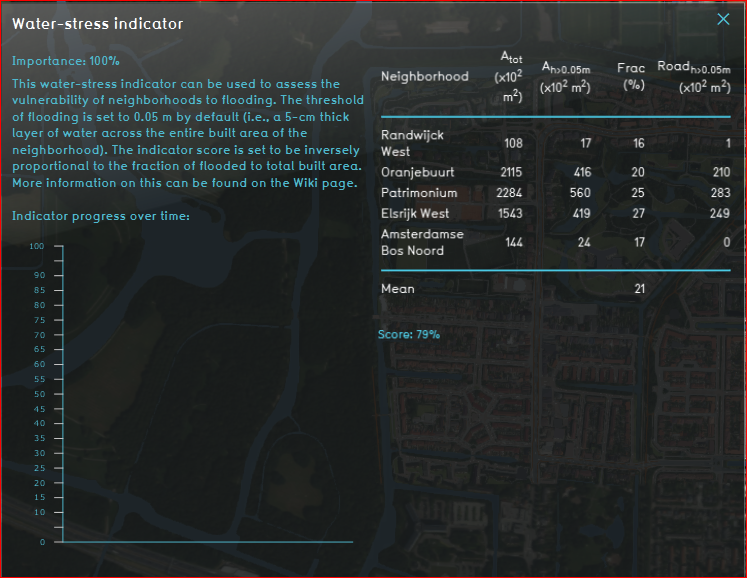Water stress (Indicator): Difference between revisions
| Line 21: | Line 21: | ||
A progress bar, that runs from 0 to 100%, keeps the user updated about the current state of the neighborhoods in their project in terms of flood resilience. The indicator score is set to be inversely proportional to the fraction of flooded (i.e., exceeding threshold) to total built area (averaged over the neighborhoods present in the project). For instance, if on average 21% of the built area exceeds threshold, the score will be set to (100-21=) 79%. The user decides whether they whish to display the [[Indicators#Absolute_score|absolute or relative score]]. Naturally, a higher score means better flood resilience and vice versa. | A progress bar, that runs from 0 to 100%, keeps the user updated about the current state of the neighborhoods in their project in terms of flood resilience. The indicator score is set to be inversely proportional to the fraction of flooded (i.e., exceeding threshold) to total built area (averaged over the neighborhoods present in the project). For instance, if on average 21% of the built area exceeds threshold, the score will be set to (100-21=) 79%. The user decides whether they whish to display the [[Indicators#Absolute_score|absolute or relative score]]. Naturally, a higher score means better flood resilience and vice versa. | ||
The easiest way to improve the score is by replacing paved/tarmac surface with green, which will greatly benefit the drainage capacity (i.e., the infiltration rate) of the ground surface. | Flood resilience is mainly controlled by factors such as water drainage and storage. The easiest way to improve the score is by replacing paved/tarmac surface with green, which will greatly benefit the drainage capacity (i.e., the infiltration rate) of the ground surface. On the other hand, choosing a more porous soil type or implementation of innovative measures, such as green roofs, will contribute to the [[Water storage percentage (Terrain) (Water Overlay)|water storage]]. | ||
===Preparation=== | ===Preparation=== | ||
Revision as of 12:14, 8 May 2019
General
What is the water stress indicator?
The water stress indicator yields insight into the flood resilience of built areas (default: neighborhoods) based on the fraction of total built area in that area which inundates beyond the preconfigured threshold inundation level (default: 0.05 m). Despite it being only a rather simplistic measure, it differentiates well between the more resilient (usually greener) areas and those less capable of dealing with excessive inflow of water.
Panel

By default the indicator panel (Fig. 1) displays the following information in the columns from left to right:
- Name of the neighborhood
- Total built area (m2)
- Built area exceeding the inundation threshold (m2)
- Ratio between the previous two parameters (%)
- Road/street area exceeding the inundation threshold (m2)
Note: the rightmost column is nothing more than a narrowed-down version of the 3rd column, so its values can never turn out higher.
Calculations
The indicator approximates the built area of a neighborhood using the LOTSIZE function. Then, it measures the part of that area where water accumulation exceeds the threshold of, say, 0.05 m. Next, the ratio of threshold-exceeding over total built area is multiplied by a 100%. In addition, step 2 is repeated but with the threshold-exceeding built area being replaced by threshold-exceeding roads/streets.
Score
A progress bar, that runs from 0 to 100%, keeps the user updated about the current state of the neighborhoods in their project in terms of flood resilience. The indicator score is set to be inversely proportional to the fraction of flooded (i.e., exceeding threshold) to total built area (averaged over the neighborhoods present in the project). For instance, if on average 21% of the built area exceeds threshold, the score will be set to (100-21=) 79%. The user decides whether they whish to display the absolute or relative score. Naturally, a higher score means better flood resilience and vice versa.
Flood resilience is mainly controlled by factors such as water drainage and storage. The easiest way to improve the score is by replacing paved/tarmac surface with green, which will greatly benefit the drainage capacity (i.e., the infiltration rate) of the ground surface. On the other hand, choosing a more porous soil type or implementation of innovative measures, such as green roofs, will contribute to the water storage.
Preparation
In order for the indicator to work properly, a variant of the Water Overlay needs to be added to the project, and its ID should match the number (#) as it appears in the queries containing WHERE_GRID_IS_# found in the indicator.xlsx. Once an overlay is added, e.g., Rainfall Overlay, its ID can be retrieved through the Query Tool using the query sequence SELECT_ID_WHERE_OVERLAY_IS_#.
Also, if you wish to assess the current performance of the neighborhoods, make sure the box next to 'Use absolute calculated score' is checked.
Example
- In the Editor select 'Current Situation' from the ribbon header.
- Select Overlays from the ribbon bar.
- Select Add Rainfall from the dropdown menu.
- Proceed by implementing a standardized (e.g., 1-h long, 70 mm/h) rainfall event through the Configuration Wizard.
- Let the overlay recalculate.
- Open the water stress indicator and examine its results.
Expand functionality
The default water stress indicator offers basic functionality, but allows for easy expansion, depending on the user's intentions. A first advancement has been made by differentiating the inundated road/street surface from the total built area (see rightmost column in Fig. 1).